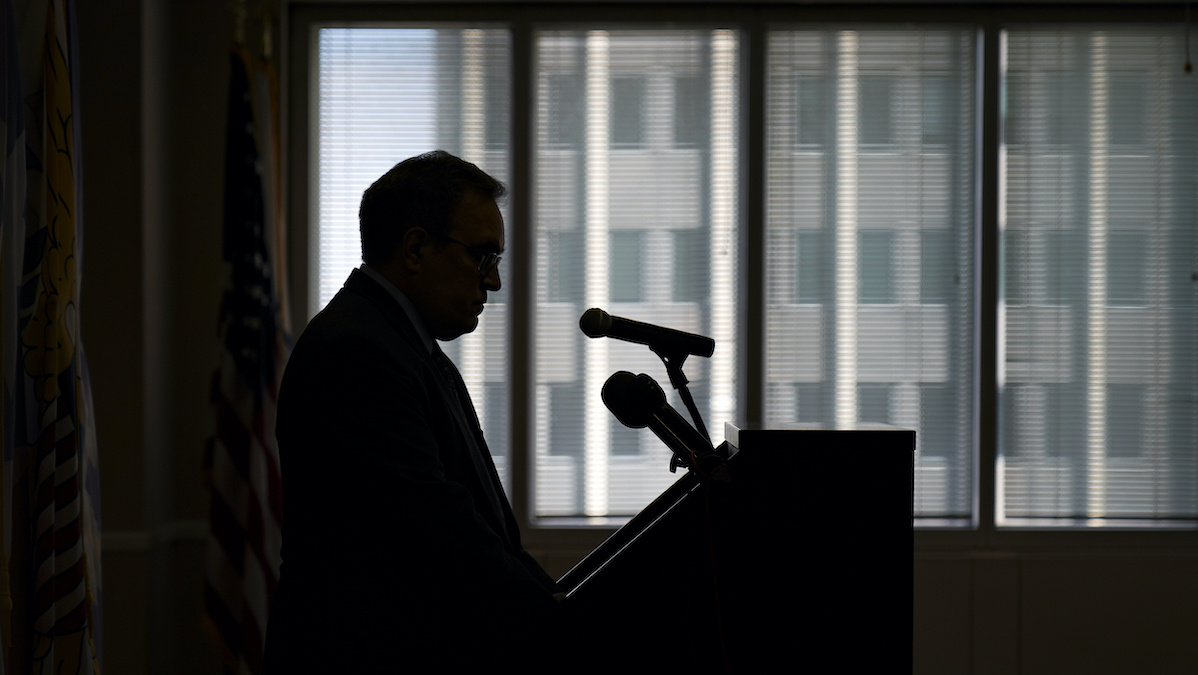

EPA Administrator Andrew Wheeler speaks at a press conference to discuss the agency's Superfund program at EPA's New York City office on March 4, 2019. Drew Angerer / Getty Images
The U.S. Environmental Protection Agency (EPA) used the cover of Super Tuesday to put out an update to its plans to limit scientific research in its decision-making on Tuesday evening, as the mass media world had its eyes focused on the election results trickling in.
The proposal, called Strengthening Transparency in Regulatory Science, is part of the agency’s ongoing push to rewrite “the foundation on which public health and environmental rules are crafted,” as E&E News reported.
As Common Dreams reported, the timing of the release was curious. In a tweet, Rebecca Leber from Mother Jones wrote, “an incredible news dump by EPA this evening. After delays, EPA just moved forward its most controversial proposal of the Trump administration, limiting science and medical data that can be used by the agency. Still far from a final rule but inching closer.”
Experts say the move, which would restrict the type of research that can be considered in public health and environmental regulations, is one of the government’s most far-reaching restrictions on science, according to The New York Times.
The proposal, which was first put forth in April 2018 by former EPA administrator Scott Pruitt, looked to exclude research where all the underlying data was not publicly available, even if that meant data was not shared because it would have violated medical privacy laws. The so-called “secret science” proposal received more than 600,000 comments during the public comment period. Most of them were critical of a proposal that would stop the agency from considering landmark public health research, according to The Hill. For example, under the proposal, the EPA would downplay studies that “definitively linked air pollution to premature deaths but relied on the personal health information of thousands of study subjects who had been guaranteed confidentiality,” according to The New York Times.
“They’re putting in nonscientific criteria to decide what science the agency can use,” said Andrew Rosenberg, director of the Center for Science and Democracy at the Union of Concerned Scientists, as The New York Times reported. “Now the most important thing is whether the data is public, not the strength of the scientific evidence.”
The new proposal makes a slight alteration. It would not flatly reject studies without publicly available information. Instead, it would create a tiered-system and give lower priority to studies where some of the data, even sensitive medical data, is not made public, according to The New York Times.
“In the midst of a public health crisis, Americans deserve a government that relies on the best available science to protect everyone against harm. This proposal does the opposite,” said Gina McCarthy, former EPA administrator and now president and CEO of the Natural Resources Defense Council, in a statement.
“Now is not the time to play games with critical medical research that underpins every rule designed to protect us from harmful pollution in our air and in our water,” McCarthy added. “This move is even more egregious than the last proposal, which the administration’s own hand-picked scientists criticized.”
The proposal seems to be in lockstep with the administration’s systematic efforts to dismantle environmental regulations and to finalize the rollbacks before this year’s election. The effort to dilute scientific-research is particularly beneficial to the fossil fuel industry, which is often hampered by studies about the climate crisis, air pollution or the safety of drinking water, as The New York Times reported.
“These additions and clarifications to the proposed rule will ensure that the science supporting the agency’s decisions is transparent and available for independent validation while still maintaining protection of confidential and personally identifiable information,” said Andrew Wheeler, the EPA’s administrator, as E&E News reported.
However, observers have a much different take on the intent of the rule.
“It’s increasing the damage of the proposed rule,” said Betsy Southerland, former director of EPA’s Office of Science and Technology and a member of the Environmental Protection Network, as E&E News reported.
“Number 1, it expands the scope of the rule, and number 2, by no means does it demonstrate they have a legal authority to do this rulemaking.”
- Blowing the Cover off the 'Cleanest Air' Illusion of the Trump ...
- EPA Proposal to Restrict Science Panders to Polluters - EcoWatch
- EPA’s ‘Secret Science’ Rule Impacts Public Health
- EPA Dismisses Harmful 'Secret Science' Rule

 233k
233k  41k
41k  Subscribe
Subscribe 